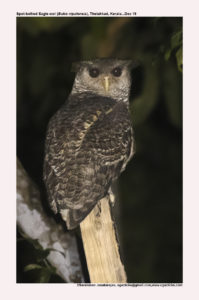
Spot-bellied Eagle Owl Bubo nipalensis
Etymology :
- Bubo : Latin word for Eurasian Eagle owl
- Nipalensis: From Nepal
Vernacular Names: Cachar: Dao bu gao deba, Bhutia: Migdori, Nepal: Huhu, Huhu cheel, Ta: Kottaan, Periya andai, Mal: Umman, Kattu munga, Sinh: Loku bakamuna, Hindi: Nepal Ghuggu, Mar: Van Huma Ghubad
Distribution in India: Resident of Himalayas, North East India and Western Ghats
Description: Size of 51–63 cm; wt. of 1300–1500 g. It is a large, powerful, dark brown owl, with well-developed, outward-slanting ear tufts composed of feathers of different sizes. The facial disc is whitish; dark brown above, mottled and barred with buffy-white; below it is buffy-white, barred with blackish on throat and breast, with dark brown v-shaped spots on lower breast and abdomen. The feathers of upperparts are dark brown, edged pale buff; tarsus are fully feathered, The irides is brown to hazel-brown; eyelids are pale grey; cere and bill are dull wax-yellow to pale yellow; toes are dusky yellowish-grey. The juvenile is conspicuously pale, buff to whitish, narrowly barred above and below, and with bluish-black irides; moults into adult plumage after 1 year.
Habitat: It is found in dense evergreen and moist deciduous forest, usually near water, montane wet temperate forest, mixed teak forest and dense riparian gallery forest;, bamboo jungle, thin deciduous forest, and edges of clearings. It is found from 300m–3000 m.
Food Habits: It eats large birds, mammals, reptile, fish and occasionally carrion. It is mostly nocturnal. It is bold and powerful hunter; hunts from perch, or pounces on roosting birds or other prey.
Breeding habits: They breed in Feb–Mar in Himalayas and Nepal and in Dec–Jan in South India. They nest in large tree cavity or abandoned stick nest of raptor; also lays on bare soil in cave or sheltered fissure in rock wall. They lay a clutch of 1 egg. They are fierce in defence of eggs, nestlings and fledged young.